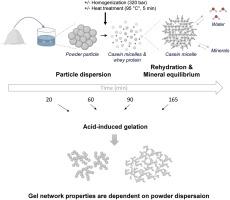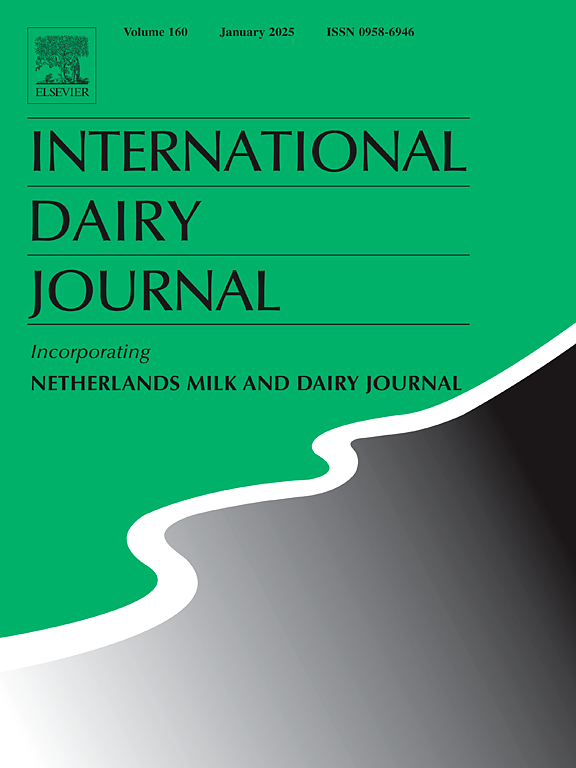Mapping the essential steps of milk protein rehydration: the importance of particle size and mineral release on acid-induced gelation
IF 3.4
3区 农林科学
Q2 FOOD SCIENCE & TECHNOLOGY
引用次数: 0
Abstract
Milk protein concentrates (MPC) are high in protein and low in lactose content and therefore suitable for low-lactose yogurts. However, MPCs are slow in rehydration, have varying buffering capacity, and can show poor water holding when used in dairy applications. This study examined how colloidal properties of MPC85 changed during reconstitution, heat treatment, and homogenization, and how this affected acid-induced gelation. It was found that short mixing times resulted in large, undispersed particles, reducing gel firmness in unheated MPC85. Both heated and unheated powders showed similar gel firmness when well-dispersed, but heated samples had better water holding. Heating MPC85 at 95 °C for 5 min reduced particle size, making samples unaffected by mixing time. Low-field NMR indicated water-protein interactions took hours to equilibrate, but the gel's rheological properties were unaffected. In conclusion, a homogeneous dispersion of casein micelles is crucial for acidified gels while full rehydration equilibrium is less important.

绘制牛奶蛋白再水化的基本步骤:颗粒大小和矿物质释放对酸诱导凝胶的重要性
牛奶浓缩蛋白(MPC)蛋白质含量高,乳糖含量低,适合制作低乳糖酸奶。然而,MPCs的再水化速度较慢,具有不同的缓冲能力,并且在乳制品应用中表现出较差的保水性。本研究考察了MPC85的胶体性质在重构、热处理和均质过程中的变化,以及这对酸诱导凝胶的影响。研究发现,较短的混合时间导致颗粒较大且不分散,降低了未加热MPC85的凝胶硬度。加热和未加热的粉末在分散良好时表现出相似的凝胶硬度,但加热后的样品具有更好的持水性。在95°C下加热MPC85 5分钟可减小粒径,使样品不受混合时间的影响。低场核磁共振表明,水-蛋白质相互作用需要数小时才能达到平衡,但凝胶的流变性能不受影响。综上所述,酪蛋白胶束的均匀分散对酸化凝胶至关重要,而完全再水化平衡则不太重要。
本文章由计算机程序翻译,如有差异,请以英文原文为准。
求助全文
约1分钟内获得全文
求助全文
来源期刊

International Dairy Journal
工程技术-食品科技
CiteScore
6.50
自引率
9.70%
发文量
200
审稿时长
49 days
期刊介绍:
The International Dairy Journal publishes significant advancements in dairy science and technology in the form of research articles and critical reviews that are of relevance to the broader international dairy community. Within this scope, research on the science and technology of milk and dairy products and the nutritional and health aspects of dairy foods are included; the journal pays particular attention to applied research and its interface with the dairy industry.
The journal''s coverage includes the following, where directly applicable to dairy science and technology:
• Chemistry and physico-chemical properties of milk constituents
• Microbiology, food safety, enzymology, biotechnology
• Processing and engineering
• Emulsion science, food structure, and texture
• Raw material quality and effect on relevant products
• Flavour and off-flavour development
• Technological functionality and applications of dairy ingredients
• Sensory and consumer sciences
• Nutrition and substantiation of human health implications of milk components or dairy products
International Dairy Journal does not publish papers related to milk production, animal health and other aspects of on-farm milk production unless there is a clear relationship to dairy technology, human health or final product quality.
 求助内容:
求助内容: 应助结果提醒方式:
应助结果提醒方式:


